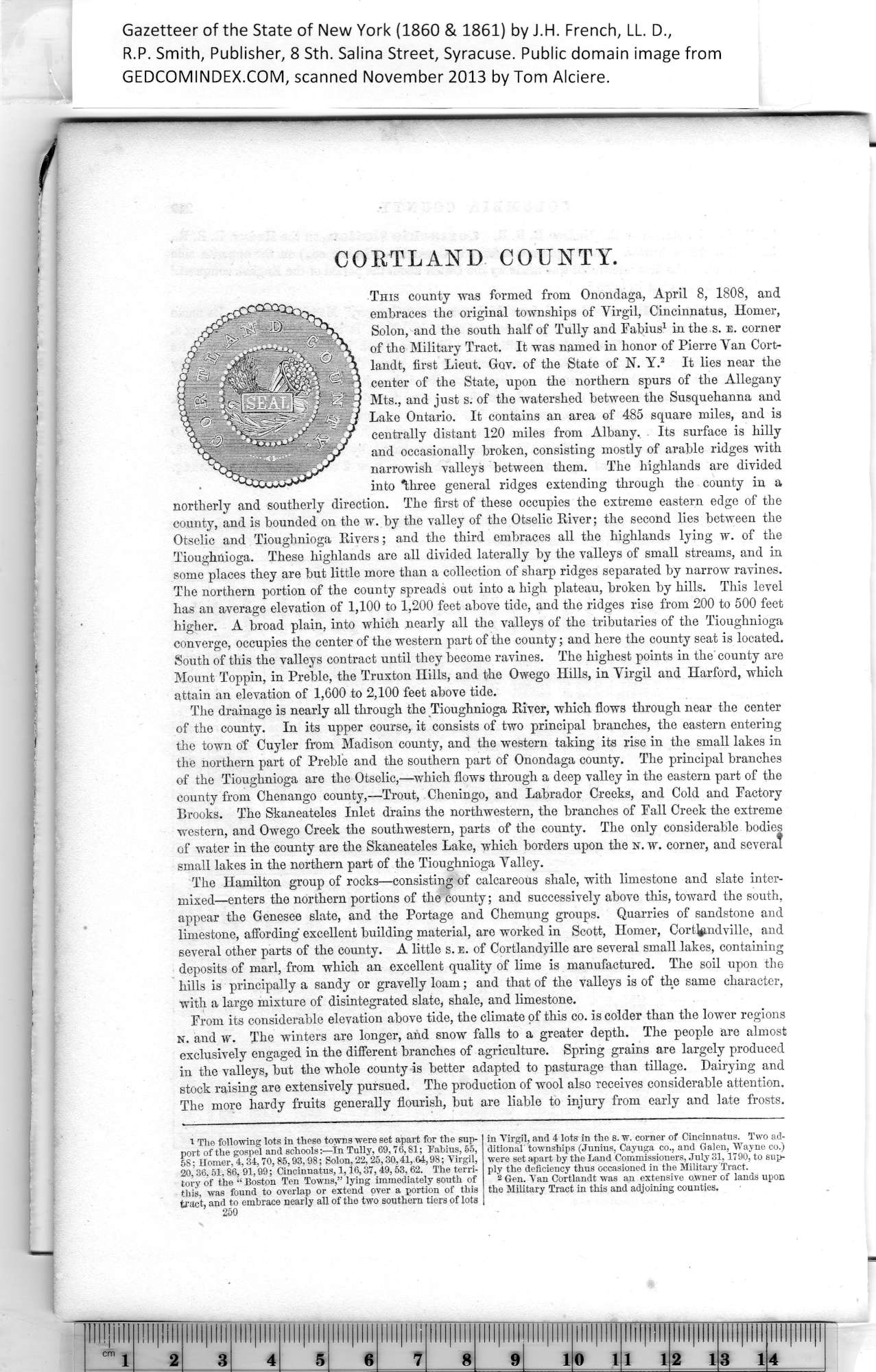|
CORTLAND COUNTY.
This county was formed from Onondaga, April 8, 1808, and
embraces the original townships of Yirgil, Cincinnatus, Homer,
Solon, and the south half of Tully and Fabius1 in the s. e. corner
of the Military Tract. It was named in honor of Pierre Yan Cort-
landt, first Lieut. Gov. of the State of N. Y.2 It lies near the
center of the State, upon the northern spurs of the Allegany
Mts., and just s. of the watershed between the Susquehanna and
Lake Ontario. It contains an area of 485 square miles, and is
centrally distant 120 miles from Albany. Its surface is hilly
and occasionally broken, consisting mostly of arable ridges with
narrowish valleys between them. The highlands are divided
into Three general ridges extending through the county in a
northerly and southerly direction. The first of these occupies the extreme eastern edge of the
county, and is bounded on the w. by the valley of the Otselie River; the second lies between the
Otselie and Tioughnioga Rivers; and the third embraces all the highlands lying w. of the
Tioughnioga. These highlands are all divided laterally by the valleys of small streams, and in
some places they are but little more than a collection of sharp ridges separated by narrow ravines.
The northern portion of the county spreads out into a high plateau, broken by hills. This level
has an average elevation of 1,100 to 1,200 feet above tide, and the ridges rise from 200 to 500 feet
higher. A broad plain, into which nearly all the valleys of the tributaries of the Tioughnioga
converge, occupies the center of the western part of the county; and here the county seat is located.
South of this the valleys contract until they become ravines. The highest points in the’ county are
Mount Toppin, in Preble, the Truxton Hills, and the Owego Hills, in Yirgil and Harford, which
attain an elevation of 1,600 to 2,100 feet above tide.
The drainage is nearly all through the Tioughnioga River, which flows through near the center
of the county. In its upper course, it consists of two principal branches, the eastern entering
the town of Cuyler from Madison county, and the western taking its rise in the small lakes in
the northern part of Preble and the southern part of Onondaga county. The principal branches
of the Tioughnioga are the Otselie,—which flows through a deep valley in the eastern part of the
county from Chenango county,—Trout, Cheningo, and Labrador Creeks, and Cold and Factory
Brooks. The Skaneateles Inlet drains the northwestern, the branches of Fall Creek the extreme
western, and Owego Creek the southwestern, parts of the county. The only considerable bodies
of water in the county are the Skaneateles Lake, which borders upon the n. w. corner, and several
small lakes in the northern part of the Tioughnioga Yalley.
The Hamilton group of rocks—consisting of calcareous shale, with limestone and slate inter¬
mixed—enters the northern portions of the county; and successively above this, toward the south,
appear the Genesee slate, and the Portage and Chemung groups. Quarries of sandstone and
limestone, affording" excellent building material, are worked in Scott, Homer, Cort^iidville, and
several other parts of the county. A little s. e. of Cortlandville are several small lakes, containing
deposits of marl, from which an excellent quality of lime is manufactured. The soil upon the
bills is principally a sandy or gravelly loam; and that of the valleys is of the same character,
with a large mixture of disintegrated slate, shale, and limestone.
From its considerable elevation above tide, the climate of this co. is colder than the lower regions
n. and w. The winters are longer, and snow falls to a greater depth. The people are almost
exclusively engaged in the different branches of agriculture. Spring grains are largely produced
in the valleys, but the whole county is better adapted to pasturage than tillage. Dairying and
stock raising are extensively pursued. The production of wool also receives considerable attention.
The more hardy fruits generally flourish, but are liable to injury from early and late frosts.
|
in Virgil, and 4 lots in the s. w. corner of Cincinnatus. Two ad¬
ditional townships (Junius, Cayuga CO., and Galen, Wayne co.)
were set apart by the Land Commissioners, July 31,1790, to sup¬
ply the deficiency thus occasioned in the Military Tract.
2 Gen. Van Cortlandt was an extensive owner of lands upon
the Military Tract in this and adjoining counties. |
1
The following lots in these towns were set apart for the sup¬
port of the gospel and schools:—in Tully, 69,76,81; Fabius, 55,
58; Homer, 4, 34, 70, 85,93, 98; Solon, 22, 25,30,41, 64,98; Virgil,
20,36,51,86, 91,99; Cincinnatus, 1,16,37,49,53,62. The terri¬
tory of the “ Boston Ten Towns,” lying immediately south of
this, was found to overlap or extend over a portion of this
tract, and to embrace nearly all of the two southern tiers of lots
250
|
